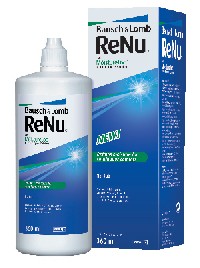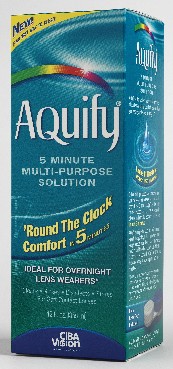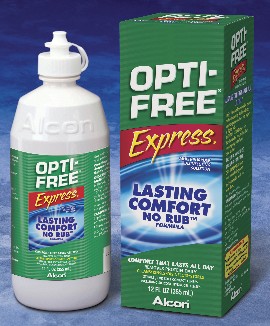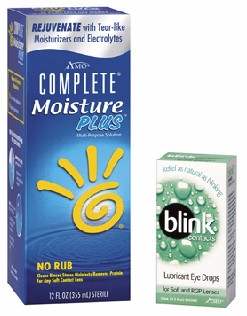IN THE TWO YEARS SINCE THESE PAGES LAST REVIEWED the improvements in lens-care solutions (August '03), a number of new and reformulated multipurpose solutions have been introduced. The last year has also seen the incorporation of sodium hyaluronate (long used in ophthalmology as Healon) into two new therapeutic rewetting drops.
One-Bottle Solutions Reign
All of this activity is a direct response to the realization that the success of contact lens wear depends upon the lens-care system. That millions of people drop out of contact lenses, and often leaving our practices, is rarely due to poor vision or poor fit. It is most often due to feelings of ocular discomfort and dryness. These are the type of problems to be solved by evaluating and changing lens-care products and/or adding supplementary drops to better lubricate and clean the lenses.
Multipurpose "one-bottle" solutions for soft lenses constitute the majority of lens-care products. Here the main focus has been to add more effective lubricants to the formulation and, at least in one instance, to change the disinfectant.
Probably the most significant reformulation has occurred in Bausch & Lomb's latest generation of ReNu, labeled as ReNu with Moisture Loc. Two new components are noteworthy.
One-Bottle Solutions Reign
All of this activity is a direct response to the realization that the success of contact lens wear depends upon the lens-care system. That millions of people drop out of contact lenses, and often leaving our practices, is rarely due to poor vision or poor fit. It is most often due to feelings of ocular discomfort and dryness. These are the type of problems to be solved by evaluating and changing lens-care products and/or adding supplementary drops to better lubricate and clean the lenses.
Multipurpose "one-bottle" solutions for soft lenses constitute the majority of lens-care products. Here the main focus has been to add more effective lubricants to the formulation and, at least in one instance, to change the disinfectant.
Probably the most significant reformulation has occurred in Bausch & Lomb's latest generation of ReNu, labeled as ReNu with Moisture Loc. Two new components are noteworthy.

Any multipurpose solution has to provide adequate disinfection without significant corneal toxicity, usually manifested as staining. B&L replaced the polyhexamethylene biguanide (PHMB) used for years in ReNu with another biguanide called Alexidine. This antimicrobial agent in a 0.00045% concentration causes cell lysis by interference with the phospholipid of the microorganism's cytoplasmic membrane. Although this product is new to ophthalmic products, it has been widely used in the dental industry. Further study will be needed to show if the elimination of PHMB will now prevent the corneal staining that has been seen with the older ReNu formulation with silicone hydrogels and Food and Drug Administration Group II lenses.
Moisture Loc, the compound responsible for the improved comfort and wetting, is a combination of polyquarternium 10 and poloxamer 407. The polyquarterium 10 is a moisture-retaining polysaccharide that creates a polymer matrix to hold water close to the lens. Poloxamer 407 is a surfactant that inhibits protein and debris from attaching to the lens surface. B&L studies have shown that Moisture Loc is retained on the contact lens over an eight-hour wearing cycle.
The other significant new reformulation is CIBA Vision's AQuify. AQuify does indeed offer an FDA-approved five-minute disinfection if there is a 10-second digital cleaning and rinsing of the lens followed by a five-minute soak. As a "no rub" product, a five-second rinse and four-hour soak are required.
Moisture Loc, the compound responsible for the improved comfort and wetting, is a combination of polyquarternium 10 and poloxamer 407. The polyquarterium 10 is a moisture-retaining polysaccharide that creates a polymer matrix to hold water close to the lens. Poloxamer 407 is a surfactant that inhibits protein and debris from attaching to the lens surface. B&L studies have shown that Moisture Loc is retained on the contact lens over an eight-hour wearing cycle.
The other significant new reformulation is CIBA Vision's AQuify. AQuify does indeed offer an FDA-approved five-minute disinfection if there is a 10-second digital cleaning and rinsing of the lens followed by a five-minute soak. As a "no rub" product, a five-second rinse and four-hour soak are required.

Targeting Wettability
The other two major products in the multipurpose lens care market, AMO's Complete Moisture Plus and Alcon's Optifree Express Lasting Comfort Formula are unchanged since my 2003 review. It is worth noting that the addition of the comfort-enhancing demulcents of propylene glycol and HPMC to Complete also serve to create a time-release cushion of moisture around the lens, the same approach to increased comfort taken by the two new competitors. The addition of taurine, an amino acid and antioxidant, protects corneal cells from osmotic stress.

To further enhance lens comfort, research and development in contact lens rewetting drops has brought us two new products, AQuify Comfort Drops from CIBA Vision and AMO Blink Contacts. These new products incorporate sodium hyaluronate (AQuify 0.1% and Blink Contacts 0.15%). Two major properties of sodium hyaluronate are beneficial to the ocular surface. The first is its capacity to hold water and thereby maintain hydration. The second is its ability to change shape to a more linear arrangement during a blink, thereby being less viscous and more lubricating. This also creates less blur with a blink than the thicker gel drops. Both products utilize new disappearing preservatives that break down to nontoxic molecules. The use of these two new products should reduce symptoms of dryness, allow patients to decrease their use of artificial tears with their preservatives and be more successful in lens wear.

For practical purposes, the differences that exist between these multipurpose solutions will not affect most contact lens wearers. However, for some patients, a particular preservative/disinfectant or a combination of surfactants will lead to complaints of dryness, irritation, redness and decreased wear time. The first thing to know is whether the patient is using the recommended solution, as many will pick up a discount generic product believing there is no difference. Secondly, are they using the product correctly? Often having a patient resume digital rubbing and rinsing prior to disinfection is enough to clean the lens and relieve the symptoms.
If neither of these approaches works, it is time to change the solution, choosing a multipurpose solution with a different disinfectant and surfactant. I often will eliminate multipurpose solutions altogether, especially if the patient has ocular hyperemia and a conjunctival papillary reaction. In these cases, CIBA Vision's Clear Care is a simple, one-step hydrogen peroxide cleaning and disinfecting system. The lens is rinsed with Clear Care, placed in a basket and the basket immersed in the Clear Care case, where neutralization is achieved with a platinum disk. In the morning, the lenses are ready to wear free of any preservatives or other chemicals. Patient education is necessary, as Clear Care cannot be used as a preinsertion rinse or placed directly in the eye.
The proper use of lens-care products and a good system of patient education are essential parts of contact lens success. This will remain true even if extended wear of silicone hydrogels grows in popularity. Fortunately, the manufacturers know this as well and are continuously improving their products to help practitioners and patients enjoy the great rewards of contact lens wear.
Dr. Key is in private practice and serves as the managing partner of Medical Center Ophthalmology LLP. He is a clinical professor of ophthalmology at the Baylor College of Medicine.




